Majid Yazdani
Leeroo Orchestrator: Elevating LLMs Performance Through Model Integration
Jan 25, 2024



Abstract:In this paper, we propose an architecture to harness the collective knowledge of multiple trained LLMs to create a new state-of-the-art. At the core of this framework is a LLM-based orchestrator that is adept at picking the right underlying LLM experts for optimal task execution. Inspired by self-play in reinforcement learning, we created a loop of query generation, orchestration, and evaluation to generate training data for the orchestrator. Our evaluation focused on the MMLU benchmark, employing models with 7B, 13B, and 34B parameters available on Hugging Face. The results demonstrate new state-of-the-art open-source models: Our Leeroo orchestrator achieves performance on par with the Mixtral model while incurring only two-thirds of its cost. Moreover, increasing the allowed cost surpasses Mixtral's accuracy by over 5% at the same cost level, reaching an accuracy of 75.9%. Further enhancements were observed when integrating GPT4 into the underlying model pool. The Leeroo orchestrator nearly matches GPT4's performance at half the cost and even exceeds GPT4's results with a 25% cost reduction. These findings illustrate the potential of our architecture in creating state-of-the-art and cost-effective LLMs by optimizing the synergy between multiple LLMs to achieve superior performance outcomes.
RQUGE: Reference-Free Metric for Evaluating Question Generation by Answering the Question
Nov 09, 2022Abstract:Existing metrics for evaluating the quality of automatically generated questions such as BLEU, ROUGE, BERTScore, and BLEURT compare the reference and predicted questions, providing a high score when there is a considerable lexical overlap or semantic similarity between the candidate and the reference questions. This approach has two major shortcomings. First, we need expensive human-provided reference questions. Second, it penalises valid questions that may not have high lexical or semantic similarity to the reference questions. In this paper, we propose a new metric, RQUGE, based on the answerability of the candidate question given the context. The metric consists of a question-answering and a span scorer module, in which we use pre-trained models from the existing literature, and therefore, our metric can be used without further training. We show that RQUGE has a higher correlation with human judgment without relying on the reference question. RQUGE is shown to be significantly more robust to several adversarial corruptions. Additionally, we illustrate that we can significantly improve the performance of QA models on out-of-domain datasets by fine-tuning on the synthetic data generated by a question generation model and re-ranked by RQUGE.
Policy Compliance Detection via Expression Tree Inference
May 24, 2022

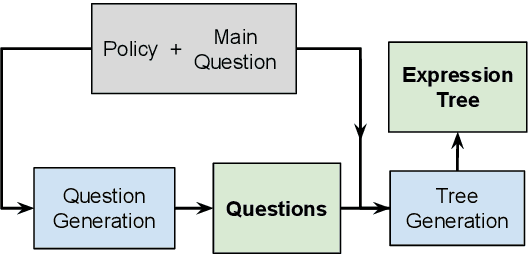
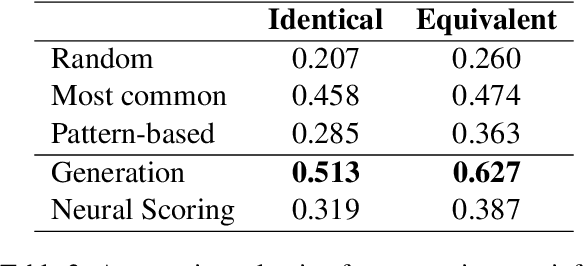
Abstract:Policy Compliance Detection (PCD) is a task we encounter when reasoning over texts, e.g. legal frameworks. Previous work to address PCD relies heavily on modeling the task as a special case of Recognizing Textual Entailment. Entailment is applicable to the problem of PCD, however viewing the policy as a single proposition, as opposed to multiple interlinked propositions, yields poor performance and lacks explainability. To address this challenge, more recent proposals for PCD have argued for decomposing policies into expression trees consisting of questions connected with logic operators. Question answering is used to obtain answers to these questions with respect to a scenario. Finally, the expression tree is evaluated in order to arrive at an overall solution. However, this work assumes expression trees are provided by experts, thus limiting its applicability to new policies. In this work, we learn how to infer expression trees automatically from policy texts. We ensure the validity of the inferred trees by introducing constrained decoding using a finite state automaton to ensure the generation of valid trees. We determine through automatic evaluation that 63% of the expression trees generated by our constrained generation model are logically equivalent to gold trees. Human evaluation shows that 88% of trees generated by our model are correct.
Open Vocabulary Extreme Classification Using Generative Models
May 12, 2022



Abstract:The extreme multi-label classification (XMC) task aims at tagging content with a subset of labels from an extremely large label set. The label vocabulary is typically defined in advance by domain experts and assumed to capture all necessary tags. However in real world scenarios this label set, although large, is often incomplete and experts frequently need to refine it. To develop systems that simplify this process, we introduce the task of open vocabulary XMC (OXMC): given a piece of content, predict a set of labels, some of which may be outside of the known tag set. Hence, in addition to not having training data for some labels - as is the case in zero-shot classification - models need to invent some labels on-the-fly. We propose GROOV, a fine-tuned seq2seq model for OXMC that generates the set of labels as a flat sequence and is trained using a novel loss independent of predicted label order. We show the efficacy of the approach, experimenting with popular XMC datasets for which GROOV is able to predict meaningful labels outside the given vocabulary while performing on par with state-of-the-art solutions for known labels.
PERFECT: Prompt-free and Efficient Few-shot Learning with Language Models
Apr 03, 2022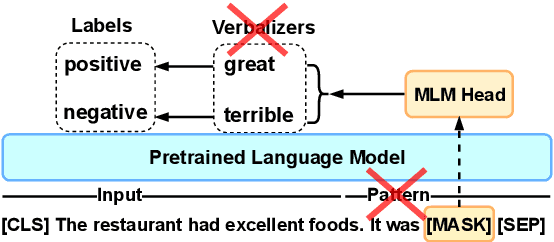
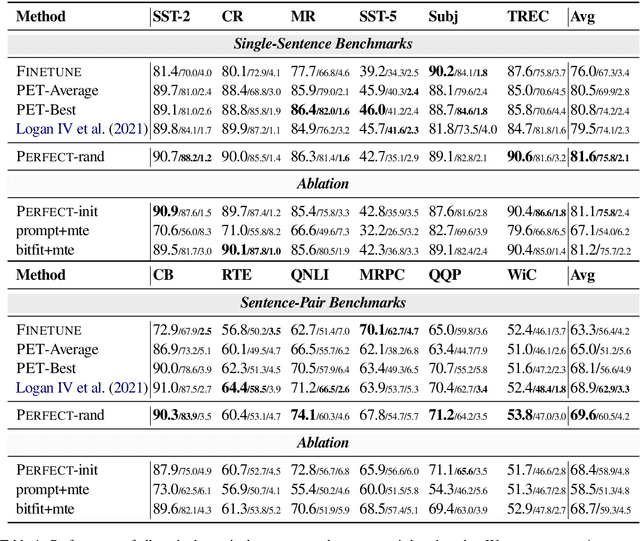
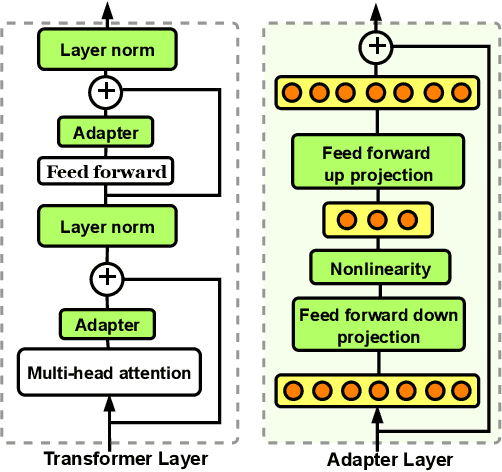
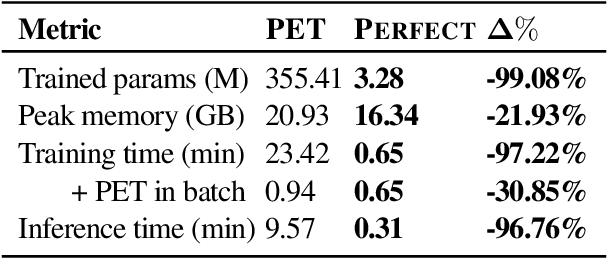
Abstract:Current methods for few-shot fine-tuning of pretrained masked language models (PLMs) require carefully engineered prompts and verbalizers for each new task to convert examples into a cloze-format that the PLM can score. In this work, we propose PERFECT, a simple and efficient method for few-shot fine-tuning of PLMs without relying on any such handcrafting, which is highly effective given as few as 32 data points. PERFECT makes two key design choices: First, we show that manually engineered task prompts can be replaced with task-specific adapters that enable sample-efficient fine-tuning and reduce memory and storage costs by roughly factors of 5 and 100, respectively. Second, instead of using handcrafted verbalizers, we learn new multi-token label embeddings during fine-tuning, which are not tied to the model vocabulary and which allow us to avoid complex auto-regressive decoding. These embeddings are not only learnable from limited data but also enable nearly 100x faster training and inference. Experiments on a wide range of few-shot NLP tasks demonstrate that PERFECT, while being simple and efficient, also outperforms existing state-of-the-art few-shot learning methods. Our code is publicly available at https://github.com/rabeehk/perfect.
Cross-Policy Compliance Detection via Question Answering
Sep 08, 2021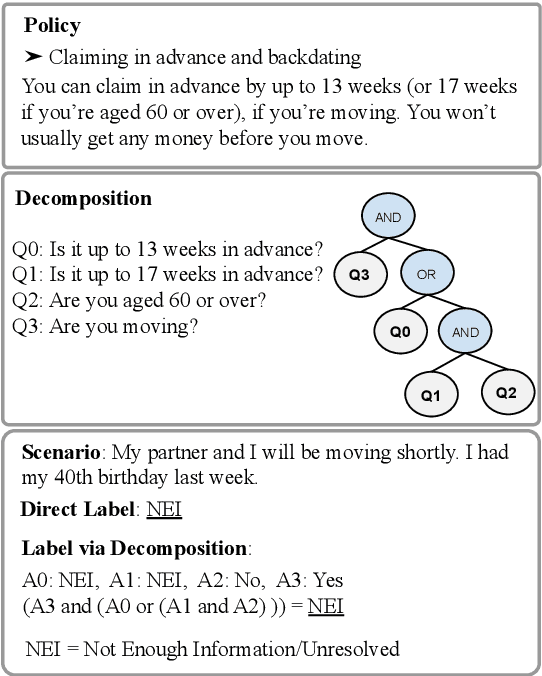



Abstract:Policy compliance detection is the task of ensuring that a scenario conforms to a policy (e.g. a claim is valid according to government rules or a post in an online platform conforms to community guidelines). This task has been previously instantiated as a form of textual entailment, which results in poor accuracy due to the complexity of the policies. In this paper we propose to address policy compliance detection via decomposing it into question answering, where questions check whether the conditions stated in the policy apply to the scenario, and an expression tree combines the answers to obtain the label. Despite the initial upfront annotation cost, we demonstrate that this approach results in better accuracy, especially in the cross-policy setup where the policies during testing are unseen in training. In addition, it allows us to use existing question answering models pre-trained on existing large datasets. Finally, it explicitly identifies the information missing from a scenario in case policy compliance cannot be determined. We conduct our experiments using a recent dataset consisting of government policies, which we augment with expert annotations and find that the cost of annotating question answering decomposition is largely offset by improved inter-annotator agreement and speed.
Database Reasoning Over Text
Jun 02, 2021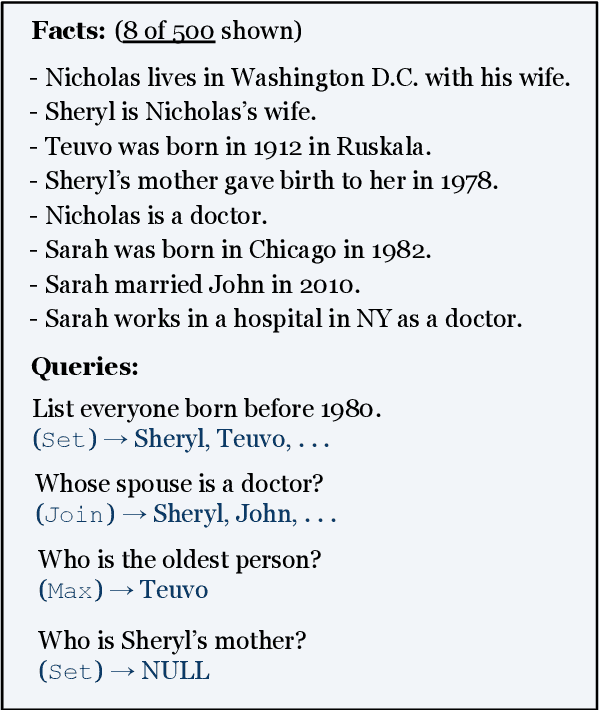
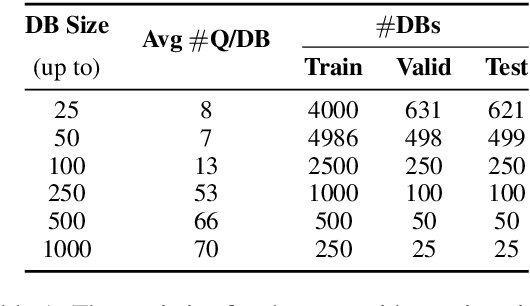

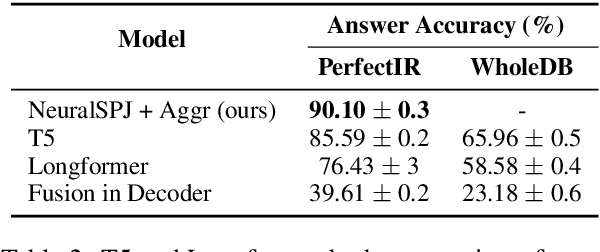
Abstract:Neural models have shown impressive performance gains in answering queries from natural language text. However, existing works are unable to support database queries, such as "List/Count all female athletes who were born in 20th century", which require reasoning over sets of relevant facts with operations such as join, filtering and aggregation. We show that while state-of-the-art transformer models perform very well for small databases, they exhibit limitations in processing noisy data, numerical operations, and queries that aggregate facts. We propose a modular architecture to answer these database-style queries over multiple spans from text and aggregating these at scale. We evaluate the architecture using WikiNLDB, a novel dataset for exploring such queries. Our architecture scales to databases containing thousands of facts whereas contemporary models are limited by how many facts can be encoded. In direct comparison on small databases, our approach increases overall answer accuracy from 85% to 90%. On larger databases, our approach retains its accuracy whereas transformer baselines could not encode the context.
Neural Databases
Oct 14, 2020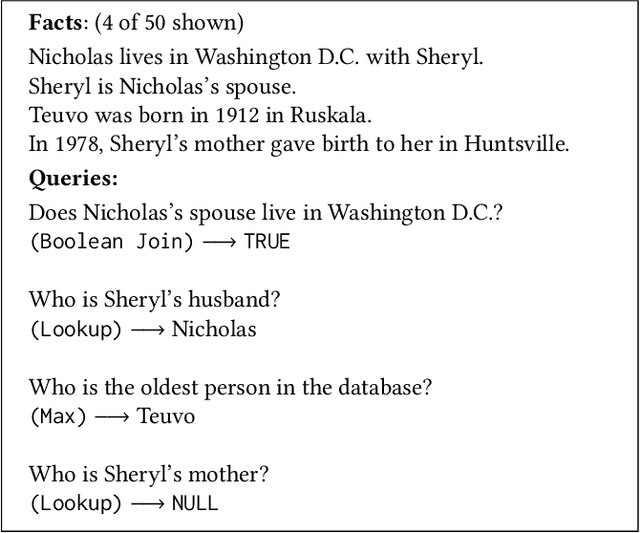

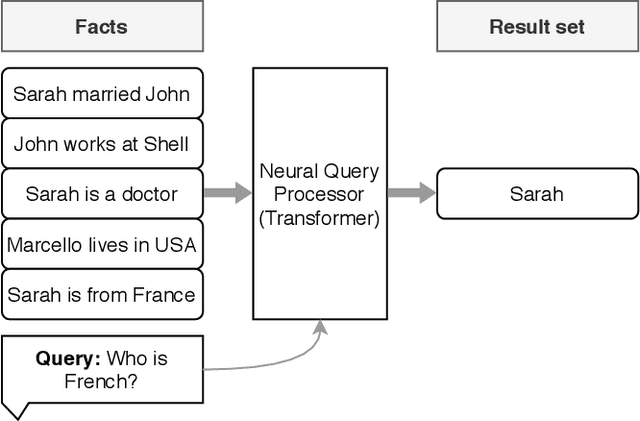

Abstract:In recent years, neural networks have shown impressive performance gains on long-standing AI problems, and in particular, answering queries from natural language text. These advances raise the question of whether they can be extended to a point where we can relax the fundamental assumption of database management, namely, that our data is represented as fields of a pre-defined schema. This paper presents a first step in answering that question. We describe NeuralDB, a database system with no pre-defined schema, in which updates and queries are given in natural language. We develop query processing techniques that build on the primitives offered by the state of the art Natural Language Processing methods. We begin by demonstrating that at the core, recent NLP transformers, powered by pre-trained language models, can answer select-project-join queries if they are given the exact set of relevant facts. However, they cannot scale to non-trivial databases and cannot perform aggregation queries. Based on these findings, we describe a NeuralDB architecture that runs multiple Neural SPJ operators in parallel, each with a set of database sentences that can produce one of the answers to the query. The result of these operators is fed to an aggregation operator if needed. We describe an algorithm that learns how to create the appropriate sets of facts to be fed into each of the Neural SPJ operators. Importantly, this algorithm can be trained by the Neural SPJ operator itself. We experimentally validate the accuracy of NeuralDB and its components, showing that we can answer queries over thousands of sentences with very high accuracy.
KILT: a Benchmark for Knowledge Intensive Language Tasks
Sep 04, 2020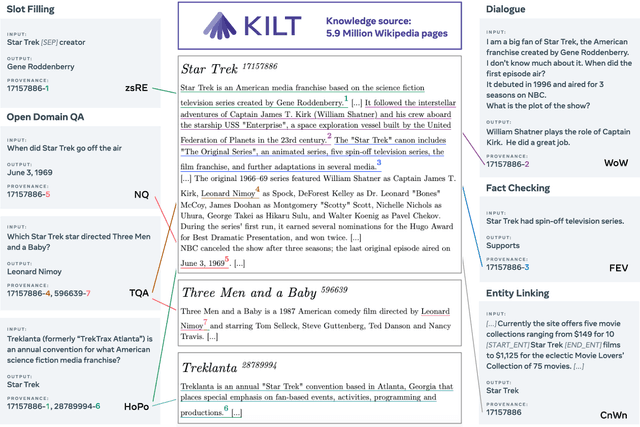
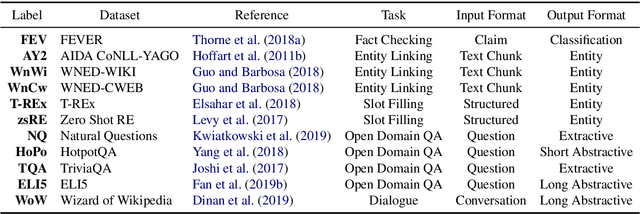
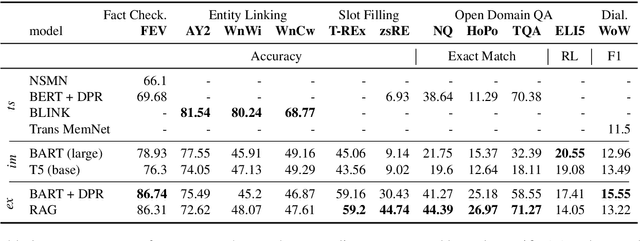
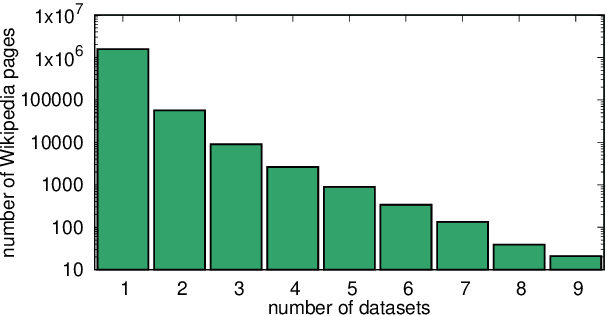
Abstract:Challenging problems such as open-domain question answering, fact checking, slot filling and entity linking require access to large, external knowledge sources. While some models do well on individual tasks, developing general models is difficult as each task might require computationally expensive indexing of custom knowledge sources, in addition to dedicated infrastructure. To catalyze research on models that condition on specific information in large textual resources, we present a benchmark for knowledge-intensive language tasks (KILT). All tasks in KILT are grounded in the same snapshot of Wikipedia, reducing engineering turnaround through the re-use of components, as well as accelerating research into task-agnostic memory architectures. We test both task-specific and general baselines, evaluating downstream performance in addition to the ability of the models to provide provenance. We find that a shared dense vector index coupled with a seq2seq model is a strong baseline, outperforming more tailor-made approaches for fact checking, open-domain question answering and dialogue, and yielding competitive results on entity linking and slot filling, by generating disambiguated text. KILT data and code are available at https://github.com/facebookresearch/KILT.
SESA: Supervised Explicit Semantic Analysis
Aug 10, 2017



Abstract:In recent years supervised representation learning has provided state of the art or close to the state of the art results in semantic analysis tasks including ranking and information retrieval. The core idea is to learn how to embed items into a latent space such that they optimize a supervised objective in that latent space. The dimensions of the latent space have no clear semantics, and this reduces the interpretability of the system. For example, in personalization models, it is hard to explain why a particular item is ranked high for a given user profile. We propose a novel model of representation learning called Supervised Explicit Semantic Analysis (SESA) that is trained in a supervised fashion to embed items to a set of dimensions with explicit semantics. The model learns to compare two objects by representing them in this explicit space, where each dimension corresponds to a concept from a knowledge base. This work extends Explicit Semantic Analysis (ESA) with a supervised model for ranking problems. We apply this model to the task of Job-Profile relevance in LinkedIn in which a set of skills defines our explicit dimensions of the space. Every profile and job are encoded to this set of skills their similarity is calculated in this space. We use RNNs to embed text input into this space. In addition to interpretability, our model makes use of the web-scale collaborative skills data that is provided by users for each LinkedIn profile. Our model provides state of the art result while it remains interpretable.
 Add to Chrome
Add to Chrome Add to Firefox
Add to Firefox Add to Edge
Add to Edge